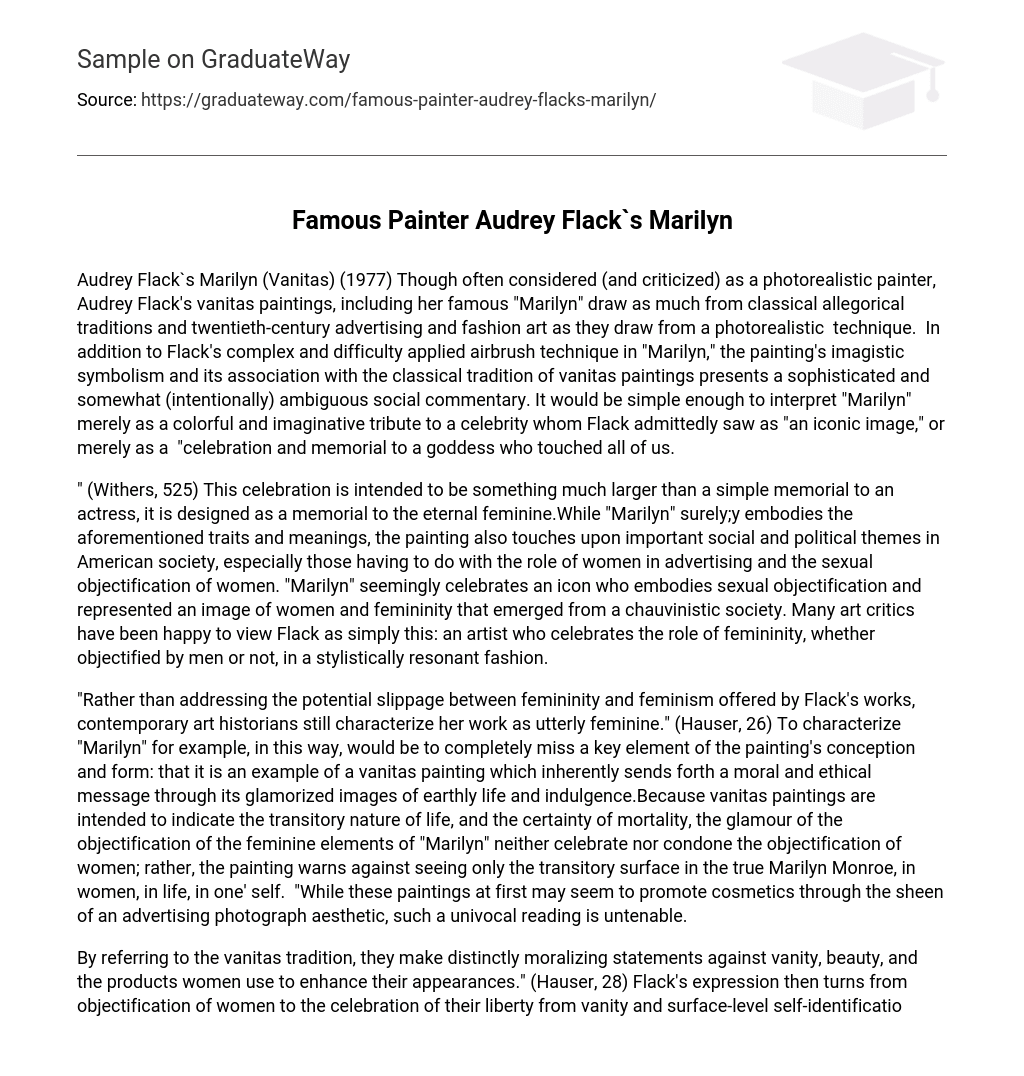Audrey Flack`s Marilyn (Vanitas) (1977) Though often considered (and criticized) as a photorealistic painter, Audrey Flack’s vanitas paintings, including her famous “Marilyn” draw as much from classical allegorical traditions and twentieth-century advertising and fashion art as they draw from a photorealistic technique. In addition to Flack’s complex and difficulty applied airbrush technique in “Marilyn,” the painting’s imagistic symbolism and its association with the classical tradition of vanitas paintings presents a sophisticated and somewhat (intentionally) ambiguous social commentary. It would be simple enough to interpret “Marilyn” merely as a colorful and imaginative tribute to a celebrity whom Flack admittedly saw as “an iconic image,” or merely as a “celebration and memorial to a goddess who touched all of us.
” (Withers, 525) This celebration is intended to be something much larger than a simple memorial to an actress, it is designed as a memorial to the eternal feminine.While “Marilyn” surely;y embodies the aforementioned traits and meanings, the painting also touches upon important social and political themes in American society, especially those having to do with the role of women in advertising and the sexual objectification of women. “Marilyn” seemingly celebrates an icon who embodies sexual objectification and represented an image of women and femininity that emerged from a chauvinistic society. Many art critics have been happy to view Flack as simply this: an artist who celebrates the role of femininity, whether objectified by men or not, in a stylistically resonant fashion.
“Rather than addressing the potential slippage between femininity and feminism offered by Flack’s works, contemporary art historians still characterize her work as utterly feminine.” (Hauser, 26) To characterize “Marilyn” for example, in this way, would be to completely miss a key element of the painting’s conception and form: that it is an example of a vanitas painting which inherently sends forth a moral and ethical message through its glamorized images of earthly life and indulgence.Because vanitas paintings are intended to indicate the transitory nature of life, and the certainty of mortality, the glamour of the objectification of the feminine elements of “Marilyn” neither celebrate nor condone the objectification of women; rather, the painting warns against seeing only the transitory surface in the true Marilyn Monroe, in women, in life, in one’ self. “While these paintings at first may seem to promote cosmetics through the sheen of an advertising photograph aesthetic, such a univocal reading is untenable.
By referring to the vanitas tradition, they make distinctly moralizing statements against vanity, beauty, and the products women use to enhance their appearances.” (Hauser, 28) Flack’s expression then turns from objectification of women to the celebration of their liberty from vanity and surface-level self-identification.”Marilyn,” then, rather than asking women to bow down to a male-centered vision of femininity, invites its viewers to see beneath the glitz and glamour surface of the ephemeral trappings of beauty and femininity and see into the lasting and eternal virtues embodied by the feminine. One indication that Flack intends to celebrate the true power of femininity is her accentuation of scale in “Marilyn:” ” For Flack, scale is content.
The content of women’s lives, as represented by the paint pots and jewelry, the keepsakes, the food and lovely dishes, is given an unaccustomed importance by their very size, and by the evidently painstakingly and laborious airbrush technique that Flack uses.” (Withers, 524) Exaggerating the scale of the objects helps to impress upon the viewer the objects’ less-obvious qualities.By enhancing the importance of the individual objects in the painting and by “reducing” the image of Marilyn Monroe herself to object size, Flack is making an ironic statement about the objectification of both women,and also the aspects of femininity that are of crucial importance to society. The magnification of the ordinary objects with the iconic face of Marilyn is meant to both unite the vision of iconic feminity with everyday, pragmatic realities, and also to unite the everyday business of life with the eternal feminine.
To accomplish this, Flack relies on the devices of imagery which are common in the vanitas tradition: “Flack uses much of the traditional vanitas genre: the watch, hourglass, rose, and fruits all testify to the transitory nature of time and the inevitability of death.” (Withers, 524) However, as mentioned, by tying these ephemeral images to an enduring, iconic image (behind the symbolism of which lies, perhaps, a goddess image as Flack herself suggested), Flack brings all of the temporal elements into the realm of the eternal. This dichotomy, plus the dichotomy described above between surface-level objectification and inner-revelation of femininity, drives the tension and release of “Marilyn,” investing the painting with drama, universal imagery, and swift cultural association.Flack’s cultural commentary can then be said to be soundly “feminist” in that it celebrates the release of the inner-feminine from the outer-trapppings imposed by patriarchal society.
However, Flack is not led to abandon or divest even the surface level trappings of beauty of their power; in doing so, one may as well concede absolute defeat to one’s oppressors. Beauty and feminity are not incompatible with a feminist vision as “Marilyn” certainly makes clear. Rejecting Flack’s feminist celebration would be narrow-minded “the feminism that rejects such sites does so as part of a “radical” critique of patriarchy, a tactic aligned with a paradoxically more conservative cultural criticism..
.” (Hauser, 28) Flack’s cultural criticism can be considered radical from both an aesthetic and conceptual viewpoint. Her use of photorealistic fashion phot techniques with the vanitas tradition marks an important articulation of feminist themes in the realm of visual arts. Works Cited Withers, Josephine.
1980 .”Monumental Still Lives.” Feminist Studies, Vol. 6,.
No. 3., pp 524- 529p Hauser, Katherine. 2002.
“Audrey Flack’s Still Lifes: Between Femininity and Feminism.” Feminist Studies, Vol. 22,. No.
2,. pp1+126-30. Bottom of Form 0





